1. Preambel
List of Authors: Jens Fitzke, Torsten Friebe, Lyn Goltz, Sabine Schmitz, Dirk Stenger.
lat/lon - Gesellschaft für raumbezogene Informationssysteme mbH
info@lat-lon.de, http://www.lat-lon.de/
Aennchenstraße 19, D-53177 Bonn, Germany
© Copyright 2020-2021 lat/lon GmbH, Bonn, Germany.
2. Introduction
The deegree OGC API Features (OAF) implementation is compliant to the latest OGC Standards called OGC API - Features - Part 1: Core and Part 2: CRS. deegree OAF provides a server implementation that has been developed based on deegree’s existing workspace concept using the API of deegree webservices. Compared to deegree webservices where spatial data is provided via services such as WFS and WMS with deegree OAF spatial data can be served with a resource-oriented approach.
2.1. OGC API family
The OGC API family of standards are being developed to make it easy for anyone to provide geospatial data to the web. These standards build upon the legacy of the OGC Web Service standards (WMS, WFS, WCS, WPS, etc.), but define resource-centric APIs that take advantage of modern web development practices.
Read more at www.ogcapi.org about the new standards and their goals. The OGC E-learning tutorial provides a chapter about the new standards and explains the basic concepts.
2.2. Features
deegree OAF supports the following Konformitätsklassen:
-
Core (Part 1)
-
Verfügbare Koordinaten-Referenzsysteme by Reference (Part 2)
Based on that requirements class deegree OAF provides implementations of representations for spatial data using encodings such as:
-
HTML,
-
GeoJSON,
-
Geography Markup Language (GML), Simple Features Profile, Level 0, and
-
Geography Markup Language (GML), Simple Features Profile, Level 2.
The Web API is provided as an Open API 3.0 document implementing the requirements class:
-
OpenAPI Specification 3.0.
deegree OAF was built on top of the robust API and configuration concept of deegree webservices. Notable features:
-
easy to install: simple deployment in every Java Servlet container
-
easy to configure: uses the deegree workspace configuration concept
-
connects to several data sources such as files, and databases
-
serves a rich HTML output format including a map component based on OpenLayers
-
links to metadata in different formats
-
supports data types such as arrays and structured objects
-
supports a bulk download for datasets as specified by requirements class "INSPIRE-bulk-download"
2.3. Quick Start
-
Install the deegree OAF webapp on your preferred Java Servlet container (the runtime environment). See section Installation for more information.
-
Create the necessary deegree configuration files stored within a deegree workspace with at least one datasource. Which files are required is described in section Configuration.
-
Install deegree OAF webapp and start the runtime environment. This is described in section Start the webapp.
-
Start a browser and open the OpenAPI specification. How to use the Web API document is explained in section OpenAPI document.
-
Browse the content using the HTML interface. How to access the data is described in section Using the HTML interface.
3. Terms and Definitions
For simplicity, this document consistently uses:
-
"OGC API" to refer to the family of standards for geospatial Web APIs.
-
"OGC API - Features" to refer to the standard OGC API - Features.
-
"deegree OAF" to refer to the implementation of "OGC API - Features" based on deegree.
Furthermore the following terms are used in this document:
3.1. dataset
Is a collection of data. In the context of deegree OAF a dataset is the set of feature types provided by a feature store. It is identified by it’s {datasetId}.
3.2. datasource
Is a source containing data retrieved from a file or a database. In the context of deegree OAF a datasource can be a feature store implementation. Which feature store implementations are supported is explaind in section Feature store configuration.
3.3. feature
Is an abstraction of real world phenomena. In the context of deegree OAF it is a spatial entity stored in a datasource. It is identified by it’s {featureId}.
3.4. feature collection
Is a set of features from a dataset. It is identified by it’s {collectionId}.
3.5. feature store
Is a ressource within the deegree workspace providing access to stored features. In the context of deegree OAF a feature store provides access to datasource such as SHAPE file or a database.
3.6. metadata
Is a description of the dataset. In the context of deegree OAF metadata can be linked per dataset.
3.7. WebAPI
An API using an architectural style that is based upon open standards and best practices such as OpenAPI Specification and it’s implementation Swagger.
3.8. webapp
Is a deployable instance of a web application. In the context of deegree OAF it is a Web application ARchive (WAR) containing all resources that together constitute the deegree OAF application.
3.9. workspace
Is a directory structure containing configuration files. Most configuration files are in XML format. Read more in Configuration how to configure deegree OAF.
4. Installation
There are many ways to install deegree OAF. This section will describe the various installation paths available.
4.1. Requirements
deegree OAF works on every Java Servlet container implementing the Java Servlet API 3.1 using an OpenJDK or Oracle JRE 11. The JRE and Java Servlet container constitute the runtime environment. The installation of these components must be done prior of this installation.
The server hosting the service should have at least 4 GB of free memory and more than 2 CPU cores available.
|
Note
|
AdoptOpenJDK 11 with Apache Tomcat 9 is the recommended runtime environment. |
4.2. Download
The deegree OGC API webapp is provided as a web application archive (WAR) file and release versions are available on the deegree OGC API GitHub page.
Choose either the deegree-ogcapi-webapp-postgres.war for PostgreSQL/PostGIS or the deegree-ogcapi-webapp-oracle.war for Oracle databases. Both webapps contain all required libraries and feature store implementations to access file-based feature stores (see Feature store configuration for more information which feature stores are supported). Download the WAR file and store it in the local file system of the server.
4.3. Deploy the webapp
Move the WAR file to the deployment folder of the runtime environment. For Apache Tomcat the folder is $CATALINA_HOME/webapps.
|
Note
|
Within this document the context path deegree-services-oaf for the deegree OAF webapp is used. Rename the WAR file to deegree-services-oaf.war to follow this convention. |
|
Note
|
Deploying one single webapp per runtime instance is recommended. See FAQ for more information about deployment of deegree OAF. |
4.4. Start the webapp
To start the webapp the runtime environment needs to be started. For Apache Tomcat use the start script $CATALINA/bin/startup.sh.
4.5. Stop the webapp
To stop the webapp the runtime environment needs to be stopped. For Apache Tomcat use the start script $CATALINA/bin/shutdown.sh.
4.6. Uninstallation
To uninstall the webapp:
-
Stop the runtime environment (if it is running).
-
Delete the webapp and the directory in which the deegree OAF webapp is installed.
4.7. Docker
Docker images with deegree OGC API are available on Docker Hub. This requires the installation of Docker on the server. Check the Docker documentation for requirements and installation instructions. The docker image provides all software components and no additional software installations are necessary.
Get the docker image with:
docker pull deegree/deegree-ogcapi:latest
To start a Docker container with the name ogcapi on port 8080 run the following command:
docker run --name ogcapi -d -p 8080:8080 deegree/deegree-ogcapi:latest
See the Docker CLI documentation for more information how to connect a container to a network, mount a volume into the container, or set environment variables.
4.8. Supported Browser
deegree OAF has been tested across a wide range of browsers, and operating systems.
The following browsers are supported:
-
Mozilla Firefox (80.0+), Google Chrome (85.0+), Microsoft Edge (79.0+)
If you are not using one of the browser above, you should be able to access all resources provided by deegree OAF and use the HTML pages but it might not display the site as designed, nor provide you with the best user experience.
Some browsers, particularly earlier versions, either do not or only partly support W3C standards and JavaScript. These browsers might not display the HTML pages properly. See the list of supported browsers by the Vue.js framework for more information.
5. Configuration
This section describes how to configure the deegree OAF webapp.
|
Important
|
deegree OAF is under development, and new configuration options may be added in future releases. For the latest configuration options please consult the example workspace provided with the release version! |
5.1. OAF workspace
The deegree workspace is the modular, resource-oriented and extensible configuration concept used by deegree. The deegree OAF workspace is an extension of the standard deegree workspace. A deegree OAF workspace can contain additional configuration files specific to deegree OAF.
The directory structure and related files are described by the following example. This example consists out of two datasets called trees and streets which data is stored within a PostgreSQL/PostGIS database. The following directory structure shows the files used in this example:
├── config.apikey # (1)
├── webapps.properties # (2)
└── ogcapi-workspace # (3)
├── datasources
│ └── feature # (4)
│ ├── streets.xml # (5)
│ └── trees.xml # (6)
├── html # (7)
│ ├── htmlview.xml # (8)
│ ├── streetsview.xml # (9)
│ ├── treesview.xml # (10)
│ └── default-style.css # (11)
├── jdbc
│ └── postgres-db.xml # (12)
├── ogcapi # (13)
│ ├── datasets.xml # (14)
│ ├── streets.xml # (15)
│ └── trees.xml # (16)
└── services
├── streets_metadata.xml # (17)
└── trees_metadata.xml # (18)
-
config file with APIKEY required to access REST-API (optional)
-
config file maps deegree OAF workspace to deegree OAF webapp (mandatory)
-
the workspace root directory (mandatory)
-
subdirectory must contain at least one feature store configuration
-
a feature store with id streets
-
a feature store with id trees
-
subdirectory with the configuration of the HTML encoding (optional)
-
global HTML encoding configuration (optional)
-
HTML encoding configuration for the dataset streets (optional)
-
HTML encoding configuration for the dataset trees (optional)
-
CSS file (optional)
-
configuration file required for database feature stores defining a JDBC connection (optional)
-
subdirectory must contain at least one dataset configuration (mandatory)
-
global dataset configuration (optional)
-
dataset configuration for the dataset streets (mandatory)
-
dataset configuration for the dataset trees (mandatory)
-
metadata configuration for dataset streets (optional)
-
metadata configuration for dataset trees (optional)
|
Important
|
The path to the deegree OAF workspace directory can be set by the environment variable DEEGREE_WORKSPACE_ROOT. The deegree OAF workspace may contain service configuration files for deegree webservices such as WFS and WMS but those services won’t be available with deegree OAF webapp!
|
More information about deegree’s workspace concept is available in the deegree webservices handbook. There you will find more information about the feature store configuration and the JDBC connection configuration.
5.2. Configuration files
The deegree OAF workspace adds the following directories to a standard deegree workspace:
-
ogcapi/: subdirectory with dataset configuration files (required)
-
html/: subdirectory with HTML encoding configuration files (optional)
A deegree OAF workspace uses the following directories of a standard deegree workspace:
-
datasources/feature/: feature store configuration files
-
jdbc/: JDBC connection configuration files
-
services/: metadata configuration files
-
config.apikey: security configuration file in the root directory of the workspace
The following chapters describe how to setup a deegree OAF workspace by the given example.
5.2.1. Datasets configuration
To provide general information about the datasets provider the following configuration file can be used:
<Datasets xmlns="http://www.deegree.org/ogcapi/datasets"
xmlns:xsi="http://www.w3.org/2001/XMLSchema-instance"
xsi:schemaLocation="http://www.deegree.org/ogcapi/datasets https://schemas.deegree.org/ogcapi/1.3/datasets.xsd">
<Title>Datasets Title</Title>
<Description>Datasets Description</Description> <!--(1)-->
<Contact>
<Name>Contact Name</Name>
<Url>https://www.deegree.org</Url>
<EMail>info@deegree.org</EMail>
</Contact>
</Datasets>-
Supports CDATA section with HTML elements
|
Note
|
The file datasets.xml shall be stored in the subdirectory ogcapi/. The file is optional. |
This configuration file can contain the following elements:
| Option | Cardinality | Value | Description |
|---|---|---|---|
Title |
0..1 |
String |
Title |
Description |
0..1 |
String |
Description |
Contact |
0..1 |
Complex |
Contact configuration |
The element <Contact/>
| Option | Cardinality | Value | Description |
|---|---|---|---|
Name |
0..1 |
String |
Name of the dataset provider |
Url |
0..1 |
String |
URL of the dataset provider |
0..1 |
String |
Email of the dataset provider |
|
Note
|
The content of this file is returned under the resource /datasets. |
5.2.2. Dataset configuration
Each dataset is configured in a separate file. The following example shows a minimal configuration for a dataset called "streets". The filename defines the {datasetId}.
<deegreeOAF xmlns="http://www.deegree.org/ogcapi/features"
xmlns:xsi="http://www.w3.org/2001/XMLSchema-instance"
xsi:schemaLocation="http://www.deegree.org/ogcapi/features https://schemas.deegree.org/ogcapi/1.3/features.xsd">
<FeatureStoreId>streets</FeatureStoreId> <!--(1)-->
<QueryCRS>http://www.opengis.net/def/crs/OGC/1.3/CRS84</QueryCRS> <!--(2)-->
<QueryCRS>http://www.opengis.net/def/crs/EPSG/0/4326</QueryCRS> <!--(3)-->
<QueryCRS>http://www.opengis.net/def/crs/EPSG/0/25832</QueryCRS> <!--(3)-->
<HtmlViewId>streetview</HtmlViewId> <!--(4)-->
</deegreeOAF>-
identifier of the feature store configuration, links to file datasources/feature/streets.xml
-
mandatory CRS, first CRS element must be
http://www.opengis.net/def/crs/OGC/1.3/CRS84as specified in OGC API Features Core specification -
additional CRS, to retrieve data in the given CRS the optional query parameter
{crs}needs to be used, see section Using query parameters for more information -
identifier of the HTML encoding configuration, links to file html/streetsview.xml
The next example shows a complete configuration for a dataset called "trees" with all options available.
<deegreeOAF xmlns="http://www.deegree.org/ogcapi/features"
xmlns:xsi="http://www.w3.org/2001/XMLSchema-instance"
xsi:schemaLocation="http://www.deegree.org/ogcapi/features https://schemas.deegree.org/ogcapi/1.3/features.xsd">
<FeatureStoreId>trees</FeatureStoreId> <!--(1)-->
<UseExistingGMLSchema>true</UseExistingGMLSchema> <!--(2)-->
<QueryCRS>http://www.opengis.net/def/crs/OGC/1.3/CRS84</QueryCRS> <!--(3)-->
<QueryCRS>http://www.opengis.net/def/crs/EPSG/0/4326</QueryCRS> <!--(4)-->
<DateTimeProperties>
<DateTimeProperty> <!--(5)-->
<FeatureTypeName xmlns:app="http://www.deegree.org/app">app:trees</FeatureTypeName>
<PropertyName xmlns:app="http://www.deegree.org/app">app:seedyear</PropertyName>
</DateTimeProperty>
</DateTimeProperties>
<HtmlViewId>treesview</HtmlViewId> <!--(6)-->
<Metadata>
<ProviderLicense> <!--(7)-->
<Name>Provider license</Name>
<Description>no limitations to public access</Description>
</ProviderLicense>
<DatasetLicense> <!--(8)-->
<Name>Dataset license</Name>
<Url>https://www.govdata.de/dl-de/by-2-0</Url>
</DatasetLicense>
<DatasetCreator> <!--(9)-->
<Name>Dataset Creator Name</Name>
<Url>http://deegree.org</Url>
<EMail>info@deegree.org</EMail>
</DatasetCreator>
<MetadataURL format="application/xml">http://example.metadata.org?service=CSW&request=GetRecordById&version=2.0.2&id=1234</MetadataURL> <!--(10)-->
<MetadataURL format="text/html">http://example.metadata.org/path_to_html/1234</MetadataURL> <!--(11)-->
</Metadata>
<ConfigureCollection id="SimpleFeature"> <!--(12)-->
<AddLink href="https://inspire.ec.europa.eu/featureconcept/XXX" rel="tag" type="text/html" title="Feature concept XXX"/>
</ConfigureCollection>
<ConfigureCollections> <!--(13)-->
<AddLink href="https://github.com/INSPIRE-MIF/XXX" rel="describedby" type="text/html" title="Encoding description"/>
</ConfigureCollections>
</deegreeOAF>-
identifier of the feature store configuration, links to file datasources/feature/trees.xml
-
activates the resource to serve the GML schema, available for schema-driven SQLFeatureStore and MemoryFeatureStore. If not provided or set to
falsethe schema file is generated by deegree. -
mandatory CRS, first CRS must be http://www.opengis.net/def/crs/OGC/1.3/CRS84 as specified in OGC API Features Core specification
-
additional CRS, to retrieve data in the given CRS the optional query parameter
{crs}needs to be used, see section Using query parameters for more information. -
DateTime property defines a property app:seedyear of the feature type app:trees as a datetime property
-
identifier of the HTML encoding configuration, links to file html/treesview.xml
-
provider license applicable to the service provider with description element
-
dataset license applicable to the dataset using link to license element
-
dataset provider contact details
-
metadata link in format
application/xmlfor the dataset (optional) -
metadata link in format
text/htmlfor the dataset (optional) -
configure additional links for an individual collection. In the example, an additional link to the INSPIRE feature concept for the collection is provided (optional) (required by INSPIRE)
-
configure additional links for all collections. In the example, an additional link to the alternative encoding description for collections is provided (optional) (recommended by INSPIRE)
|
Note
|
The dataset configuration file must be stored in the subdirectory ogcapi/. The file is mandatory. |
This configuration file can contain the following elements:
| Option | Cardinality | Value | Description |
|---|---|---|---|
FeatureStoreId |
0..n |
String |
Identifier of a feature store, see Feature store configuration which implementations are supported. This identifier also defines the {collectionId} |
QueryCRS |
0..n |
String |
The CRS codes supported, |
DateTimeProperties |
0..1 |
Complex |
Configuration of date and time properties, see parameter datetime in the OGC API specification for more information |
HtmlViewId |
0..1 |
String |
Identifier of the HTML encoding configuration, see HTML encoding configuration for more information |
Metadata |
0..1 |
Complex |
Configuration of the dataset metadata provided on the dataset’s landing page |
ConfigureCollection |
0..1 |
Complex |
Custom configuration for an individual collection |
ConfigureCollections |
0..1 |
Complex |
Custom configuration for all collections |
The element <DateTimeProperties/><DateTimeProperty/>
| Option | Cardinality | Value | Description |
|---|---|---|---|
FeatureTypeName |
0..1 |
String |
QName of the feature type |
PropertyName |
0..1 |
String |
QName of the property |
The element <Metadata/>
| Option | Cardinality | Value | Description |
|---|---|---|---|
ProviderLicense |
0..1 |
Complex |
License of the dataset provider |
DatasetLicense |
0..1 |
Complex |
License of the dataset |
DatasetCreator |
0..1 |
Complex |
Contact details of the dataset creator |
MetadataURL |
0..n |
URL |
URL of the metadata record describing the dataset, use the attribute |
The element <ConfigureCollection/>
| Option | Cardinality | Value | Description |
|---|---|---|---|
AddLink |
0..1 |
Complex |
URL of additional link |
The element <ConfigureCollections/>
| Option | Cardinality | Value | Description |
|---|---|---|---|
AddLink |
0..1 |
Complex |
URL of additional link |
The elements <ProviderLicense/><DatasetLicense/><Name/><Description/><Name/><URL/><URL/>format specifying the media type such as application/xml (default is text/html). Same applies to the element <MetadataURL/>
The <AddLink/><ConfigureCollection/><ConfigureCollections/>hrefreltypetitle
See the following section Metadata configuration for more configuration options for metadata.
|
Note
|
The content of this file is returned under the resource /datasets/{datasetId}. This resource per dataset is called landing page. Furthermore the content of this file is provided unter the resource /datasets/{datasetId}/api. |
5.2.3. Metadata configuration
The deegree service metadata configuration can be defined for each dataset. Use a file name ending with {datasetId}_metadata.xml to define the service metadata per dataset. Use the dataset identifier {datasetId} as a prefix. For example if you have a dataset configured in streets.xml the related metadata file has the file name streets_metadata.xml.
The following excerpt of the streets_metadata.xml shows which options are available:
<deegreeServicesMetadata xmlns="http://www.deegree.org/services/metadata"
xmlns:xsi="http://www.w3.org/2001/XMLSchema-instance"
xsi:schemaLocation="http://www.deegree.org/services/metadata https://schemas.deegree.org/3.5/services/metadata/metadata.xsd">
<ServiceIdentification> <!--(1)-->
<Title>deegree OGC API - Features</Title>
<Abstract>Streets of the city of Hamburg</Abstract> <!--(2)-->
</ServiceIdentification>
<DatasetMetadata>
<MetadataUrlTemplate>http://example.metadata.org/services/csw?service=CSW&request=GetRecordById&version=2.0.2&id=${metadataSetId}</MetadataUrlTemplate> <!--(3)-->
<MetadataUrlTemplate format="text/html">http://example.metadata.org/csw/htmlrepaesentation/${metadataSetId}</MetadataUrlTemplate> <!--(4)-->
<Dataset> <!--(5)-->
<Name xmlns:app="http://www.deegree.org/app">app:streets</Name> <!--(6)-->
<Title>Streets</Title> <!--(7)-->
<Abstract>Streets of the city of Hamburg</Abstract>
<MetadataSetId>beefcafe-beef-cafe-beef-cafebeefcaf</MetadataSetId>
</Dataset>
</DatasetMetadata>
</deegreeServicesMetadata>-
information about the service, in the context of OAF it is used per dataset and is shown on the landing page
-
supports CDATA section with HTML elements
-
service metadata link, in the context of OAF this link is used in the collection view link of the metadata
-
service metadata link in format
text/html, in the context of OAF this link is used in the collection view linking to the HTML representation of the metadata. -
Use this element when you have a metadata record for the defined feature collection, otherwise define the link to the metadata record on the dataset level as described in chapter Dataset configuration for the element
<MetadataURL/>. -
feature collection name which links to the feature type configured, here the {collectionId}.
-
title of the feature collection, used in HTML encoding instead of the {collectionId}
|
Note
|
The file streets_metadata.xml must be stored in the subdirectory services/. The file is mandatory. |
A detailed documentation of the deegree service metadata configuration is described in section "Metadata" of the deegree webservices handbook.
|
Note
|
The content of this file is returned under the resources /datasets/{datasetId}, /datasets/{datasetId}/collections and /datasets/{datasetId}/collections/{collectionId} providing information about metadata. |
5.2.4. Feature store configuration
Currently, deegree OAF supports the following feature stores:
-
SQLFeatureStore- retrieves data from a database supporting an extended mapping -
SimpleSQLFeatureStore- retrieves data from a database using a single table mapping -
MemoryFeatureStore- retrieves data from a file in GML file format -
ShapeFeatureStore- retrieves data from a file in SHAPE file format (Natives Koordinaten-Referenzsystem is required when using this FeatureStore)
The Natives Koordinaten-Referenzsystem defined in the feature store configuration is used to return the Content-Crs HTTP header in each response.
The supported databases for SQLFeatureStore and SimpleSQLFeatureStore are:
-
Oracle database
-
PostgreSQL/PostGIS database.
A detailed documentation of the feature store configuration is described in section "Feature Stores" of the deegree webservices handbook.
|
Note
|
The {featureId} is defined by the feature store configuration. Use the element <FIDMapping/> to define the mapping of this attribute.
|
Using schema- or table-driven FeatureStore configurations
When using a GML application schema in the feature store configuration the schema is used in the OpenAPI document for XML and JSON encoding to describe the data types (schema-driven mode). If no application schema is provided the data type description is derived from the feature store mapping (table-driven mode).
The following table shows the supported features depending on the feature store configuration.
| Table-driven | Schema-driven | Description | |
|---|---|---|---|
GML encoding |
supported |
supported |
fully supports GML 3.2 and all deegree mappings |
JSON encoding |
supported |
supported |
derived from GML encoding without feature references and complex types |
HTML encoding |
limited |
limited |
derived from JSON encoding, only primitive properties and lists of primitives |
GML schema |
provided |
provided |
linked in OpenAPI document, available at |
JSON schema |
without GML properties |
including GML properties |
data type definition is provided in OpenAPI document |
More information about table-driven and schema-driven mode is provided in section "Mapping GML application schemas" of the deegree webservices handbook.
5.2.5. HTML encoding configuration
To configure the HTML encoding a configuration file can be used. The following example contains the configuration for the dataset trees.
<HtmlView xmlns="http://www.deegree.org/ogcapi/htmlview"
xmlns:xsi="http://www.w3.org/2001/XMLSchema-instance"
xsi:schemaLocation="http://www.deegree.org/ogcapi/htmlview https://schemas.deegree.org/ogcapi/1.3/htmlview.xsd">
<CssFile>../html/lgv.css</CssFile> <!--(1)-->
<LegalNoticeUrl>https://www.hamburg.de/legalNotice/</LegalNoticeUrl> <!--(2)-->
<PrivacyPolicyUrl>https://www.hamburg.de/datenschutz/</PrivacyPolicyUrl> <!--(3)-->
<DocumentationUrl>https://www.hamburg.de/</DocumentationUrl> <!--(4)-->
<Map> <!--(5)-->
<WMSUrl version="1.3.0">https://geodienste.hamburg.de/HH_WMS_Cache_Stadtplan</WMSUrl> <!--(6)-->
<WMSLayers>stadtplan</WMSLayers> <!--(7)-->
<CrsProj4Definition code="EPSG:25832">+proj=utm +zone=32 +ellps=GRS80 +towgs84=0,0,0,0,0,0,0 +units=m +no_defs</CrsProj4Definition> <!--(8)-->
<Source><![CDATA[© <a href="https://www.hamburg.de/" target="_new">Datenquelle</a>]]></Source> <!--(9)-->
</Map>
</HtmlView>-
CSS file used for all HTML views (optional)
-
link to page containing the publishing, copyright, and legal information (optional)
-
link to page containing the privacy policy (optional)
-
link to page containing the documentation (optional)
-
configuration of the base map (optional)
-
URL of WMS used for the base map (required)
-
layer name served by the WMS used for the base map (required)
-
CRS configuration of the base map
-
adds information about the source of the base map to the map element. The text element can contain HTML packed in a CDATA section (optional)
|
Note
|
The file treesview.xml must be stored in the subdirectory html/. To define a global configuration the file name must be htmlview.xml. The file is optional. |
This configuration file can contain the following elements:
| Option | Cardinality | Value | Description |
|---|---|---|---|
CssFile |
0..1 |
URI |
relative path to a CSS file |
LegalNoticeUrl |
0..1 |
URL |
URL to external page containing the legal notice used for link in footer "Legal Notice" |
PrivacyPolicyUrl |
0..1 |
URL |
URL to an external page containing the privacy policy for link in footer "Privacy Policy" |
DocumentationUrl |
0..1 |
URL |
URL to an external page containing the documentation, if not set link in footer "Help" refers to this documentation |
Map |
0..1 |
Complex |
Configuration for the base map |
The element <Map/>
| Option | Cardinality | Value | Description |
|---|---|---|---|
WMSUrl |
1 |
URL |
WMS service endpoint URL, default: http://sg.geodatenzentrum.de/wms_dtk250. Use the attribute |
WMSLayers |
1 |
String |
Name of the layer, default: dtk250 |
CrsProj4Definition |
1 |
String |
Use the attribute |
Additional information about the option CssFile: The following elements can be configured using a CSS file: the background color of header and footer, images in header and footer, links to help, legal notice, and privacy policy.
|
Note
|
The content of this file is returned under the resources /datasets/{datasetId} for HTML encoding only. |
5.3. deegree config REST-API
deegree OAF provides a REST-API for configuration purposes. As in deegree webservices a client can use the REST interface to manage the configuration. The following operations are supported:
[HTTP METHOD] [RESOURCE] - [DESCRIPTION]
GET /config/download[/path] - download currently running workspace or file in workspace
GET /config/restart - restart currently running workspace
GET /config/restart[/path] - restarts all resources connected to the specified one
GET /config/update - update currently running workspace, rescan config files and update resources
GET /config/update/bboxcache[?featureStoreId=] - recalculates the bounding boxes of all feature stores of the currently running workspace, with the parameter 'featureStoreId' a comma separated list of feature stores to update can be passed
GET /config/list[/path] - list currently running workspace or directory in workspace
GET /config/validate[/path] - validate currently running workspace or file in workspace
PUT /config/upload/path/file - upload file into current workspace
DELETE /config/delete[/path] - delete currently running workspace or file in workspaceThe REST-API is enabled by default. To protect this interface from unauthorized use, it is automatically secured with a so-called API key. Each HTTP request requires that the API key contained in the file config.apikey is transferred.
A detailed documentation of the REST-API interface and how access is configured is described in section "deegree REST interface" of the deegree webservices handbook.
5.4. Allow access to OpenAPI document from all origins
In case you want to avoid any issues when using the OpenAPI document from other locations due to CORS, you can enable allowing all origins specifically for accessing the OpenAPI document.
To enable this set the system property deegree.oaf.openapi.cors.allow_all
6. Usage
This section describes how to access the data in the different encodings and how to use the HTML encoding to browse the data.
The main entry point for deegree OAF is provided under the resource path /datasets. Given that the deegree OAF webapp is deployed under the context path /deegree-services-oaf the resulting example URL for a local server running on port 8080 is: http://localhost:8080/deegree-services-oaf/datasets
6.1. Datasets overview
This resource provides an overview of all datasets served by deegree OAF:
| Resource | Path | HTTP method | Supported Encodings | Description |
|---|---|---|---|---|
Datasets overview |
|
GET |
|
The resource provides an overview of all datasets available |
Landing page per dataset |
|
GET |
|
The API landing page per dataset (see next section for further information) |
|
Note
|
The context for the listed resource is /datasets. This resource is not defined by the OGC API - Features standard and is an implementation specific resource. |
All resources are available in different encodings. To request a resource in a different encoding the client shall use
either the HTTP Accept header or the query parameter f to retrieve the data in the requested media type. To retrieve the supported media types per resource use the OpenAPI document available under '/api'.
6.2. Landing page per dataset
Besides the resources listed above for each dataset all resources defined by the OGC API - Features standard are supported. The configuration examples described in this document would result to the following addresses for each dataset. The landing page for the dataset trees would be served under the address http://localhost:8080/deegree-services-oaf/datasets/trees and the landing page for the dataset streets would be served under the address http://localhost:8080/deegree-services-oaf/datasets/streets.
The following table show the resources available per dataset:
| Resource | Path | HTTP method | Supported Encodings | Description |
|---|---|---|---|---|
Landing page |
|
GET |
|
Landing page is the top-level resource, which serves as an entry point per dataset |
OpenAPI |
|
GET |
|
API specification document provides metadata about the API itself |
Conformance declaration |
|
GET |
|
Declaration of Konformitätsklassen presents information about the functionality that is implemented by the server |
Feature collections |
|
GET |
|
Feature collections overview |
Feature collection |
|
GET |
|
Feature collection identified by {collectionId} |
Objekte |
|
GET |
|
List of features |
Feature |
|
GET |
|
Feature identified by {featureId} |
Provider License |
|
GET |
|
Provider license |
Dataset License |
|
GET |
|
Dataset license |
|
Note
|
The context for the listed resource is datasets/{datasetId}. The OGC API - Features standard defines all resources from this base resource. |
6.3. OpenAPI document
The OpenAPI page is available under the context /api or /openapi. The use of /api on the server is optional and the API definition may be hosted on completely separate server. If you have deployed the deegree OAF webapp under the context of deegree-services-oaf and you have a dataset configured with the name streets the resulting request path would be /deegree-services-oaf/datasets/streets/api.
The interface is grouped in the sections:
-
Capabilities - capabilities of the datasets
-
Data - access to features
-
Collections - access to feature collections
-
Schemas - access to schemas
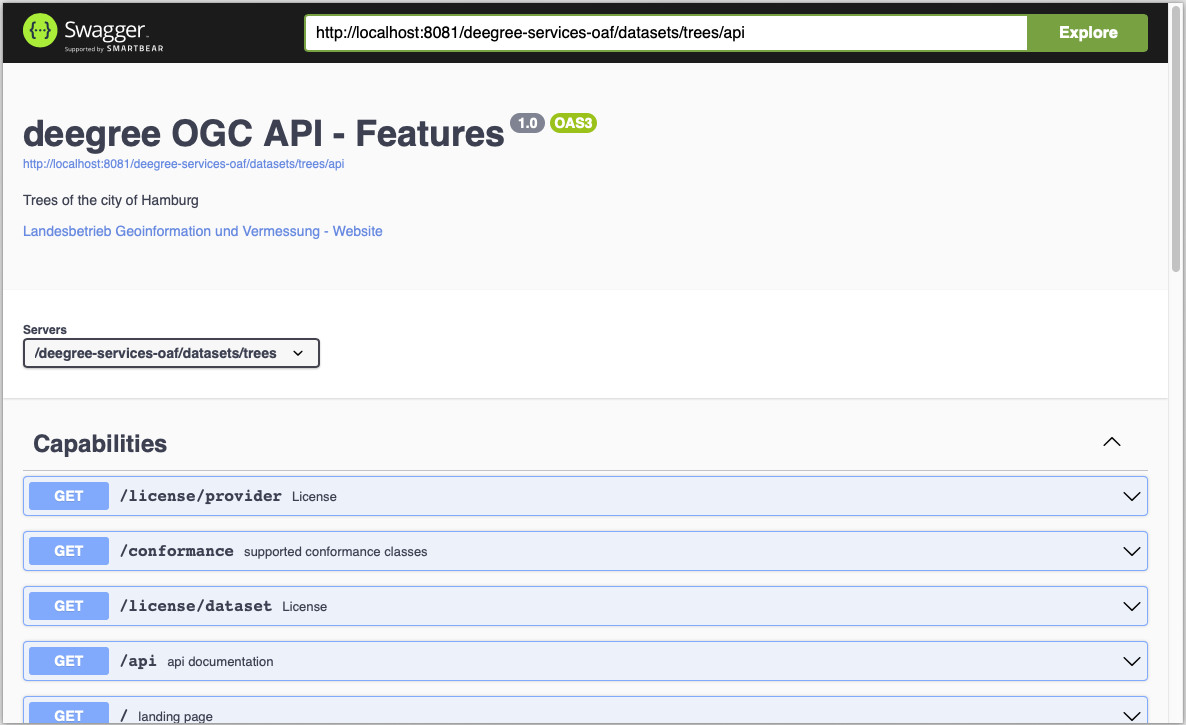
|
Note
|
For each resource in the data section a schema description is provided derived from the underlying feature store configuration. See section Feature store configuration for more information which are supported. Schema and example data may vary depending on the selected encoding and the underlying configuration. |
For all resources listed on the first three sections the following description explains how to send a request and retrieve the response in a given encoding.
6.4. Making a request
Use the generic OpenAPI specification HTML page to make a request.
Example request: Get Landing page in json encoding.
-
Click on the button "GET" next to the resource /
-
Click on the button "Try it out"
-
Select the media type
application/jsonfrom the selection list below "Responses" -
Click on the button "Execute"

The page should display the server response in the selected encoding and the HTTP status code. In addition the HTTP response header information is displayed.
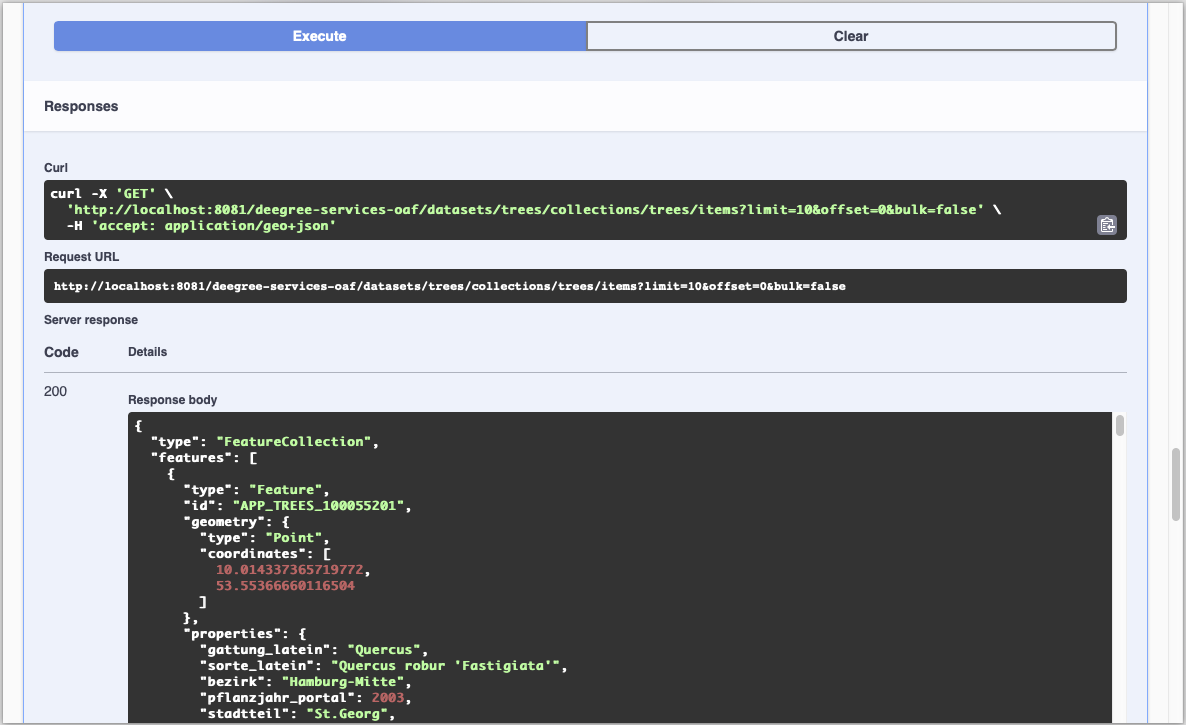
6.5. Accessing a response
To access a response in the requested encoding directly use either the given command line tool curl with the given options as displayed in the OpenAPI page when sending a request described in section Making a request.
Or use a browser and additional plugins to send the HTTP request directly. Use the HTTP Accept header or the query parameter f to define the expected response format.
| Media type | Query parameter | Accept header |
Description |
|---|---|---|---|
|
|
|
JSON/GeoJSON encoding |
|
|
|
XML/GML encoding |
|
- |
|
HTML encoding |
6.6. Accessing data in JSON/GeoJSON
To retrieve a resource in application/json encoding use the request parameter f=json.
To retrieve the landing page of the dataset streets in application/json encoding use the following request datasets/streets/?f=json.
Example URL: http://localhost:8080/deegree-services-oaf/datasets/streets/?f=json
See section Using query parameters for more information about other supported query parameters.
6.7. Accessing data in XML/GML
To retrieve a resource in application/xml encoding use the request parameter f=xml.
To retrieve the landing page of the dataset streets in application/xml encoding use the following request datasets/streets/?f=xml.
Example URL: http://localhost:8080/deegree-services-oaf/datasets/streets/?f=xml
See section Using query parameters for more information about supported other query parameters.
The corresponding GML schema file is provided under the resource of each Feature collection datasets/{datasetId}/collections/{collectionId}/appschema. Example URL: https://localhost:8080/deegree-services-oaf/datasets/streets/collections/streets/appschema
6.8. Using the HTML interface
The HTML interface provides easy access to the spatial data using a browser (check the list of Supported Browser).
It requires no additional client or browser plugin to browse the data. The browser sends by default
the HTTP header Accept with the value text/html and therefore each resource is returned in HTML encoding.
To browse the data open the browser of your choice and start at the datasets overview available at datasets/. Example URL: http://localhost:8080/deegree-services-oaf/datasets
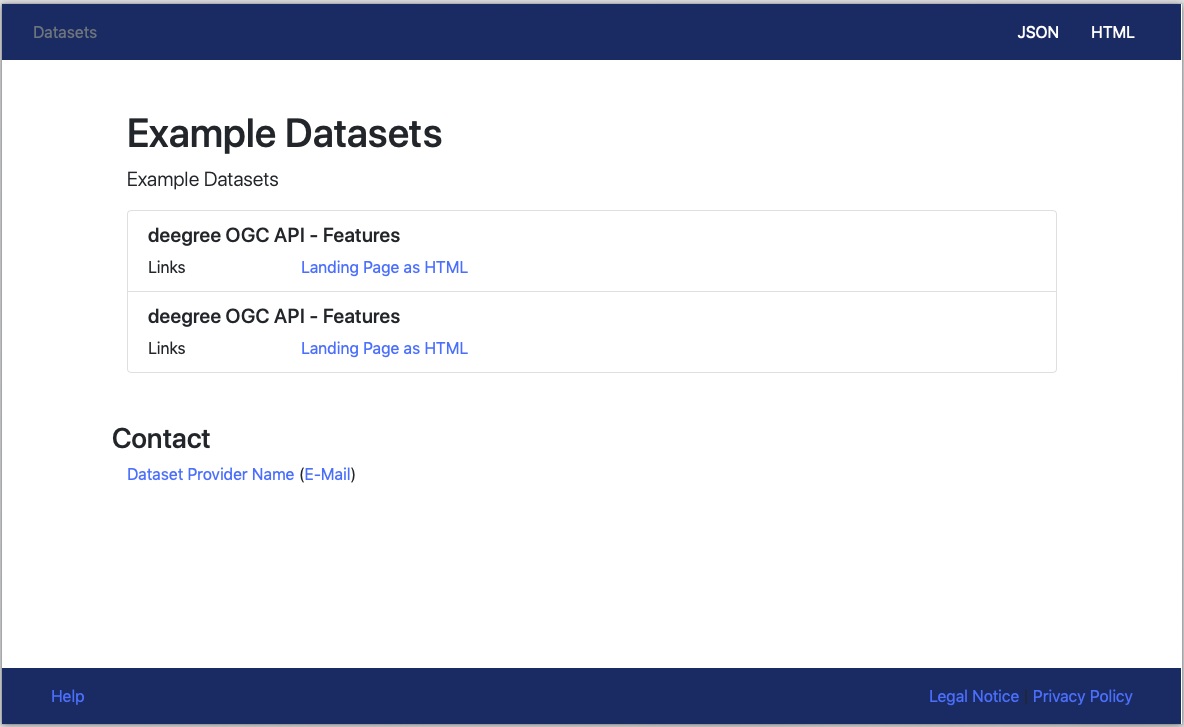
Navigate to the landing page of the dataset trees by clicking on the link "Landing page as HTML".
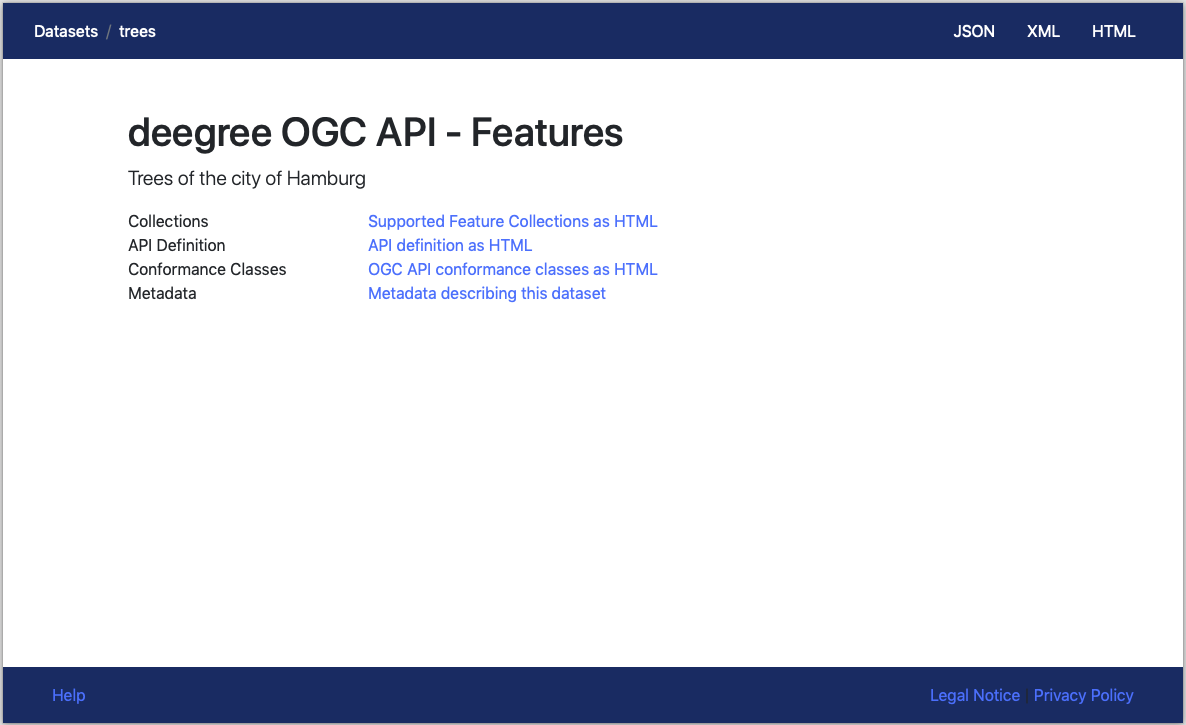
The landing page provides links to all resources of a dataset.
When navigating to the feature collections and feature collection resource links to access the referenced metadata and bulk download in GeoJson and GML encoding are provided.

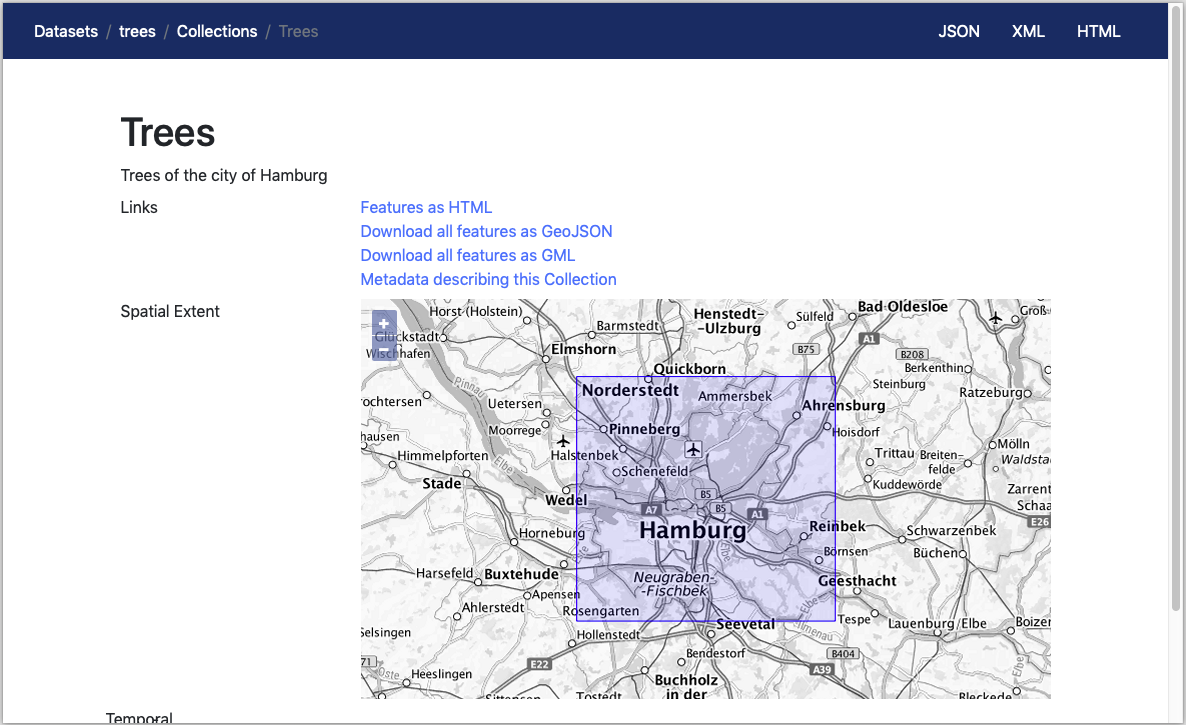
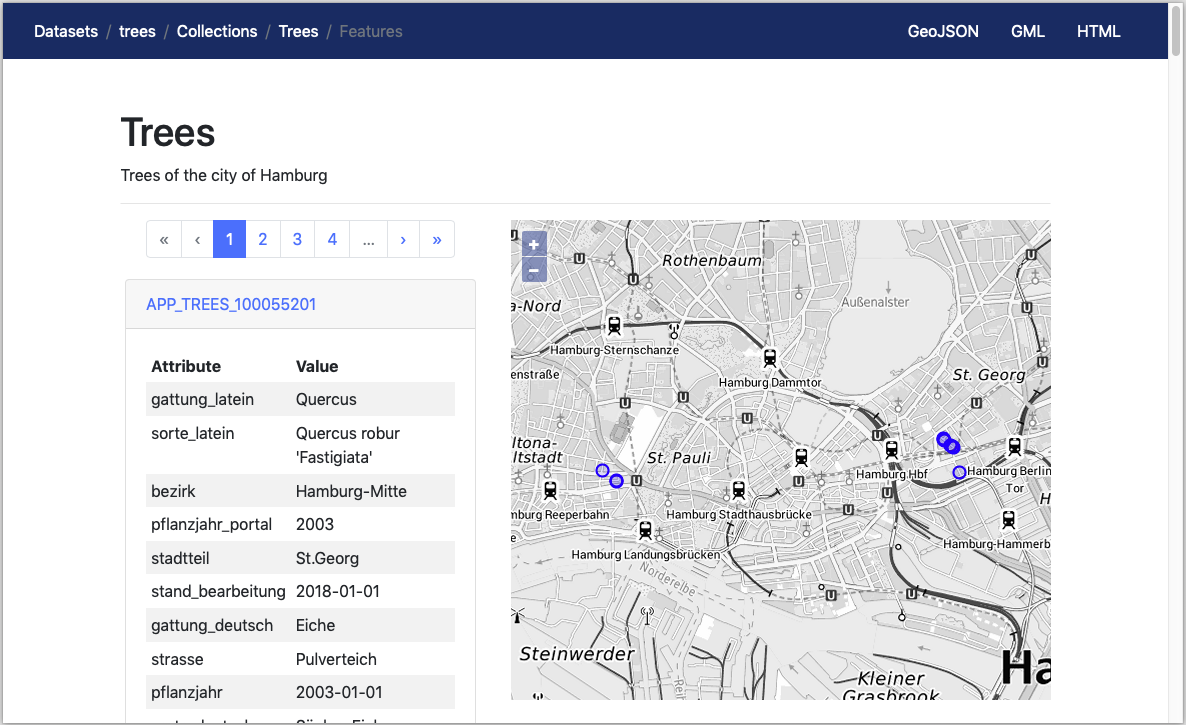
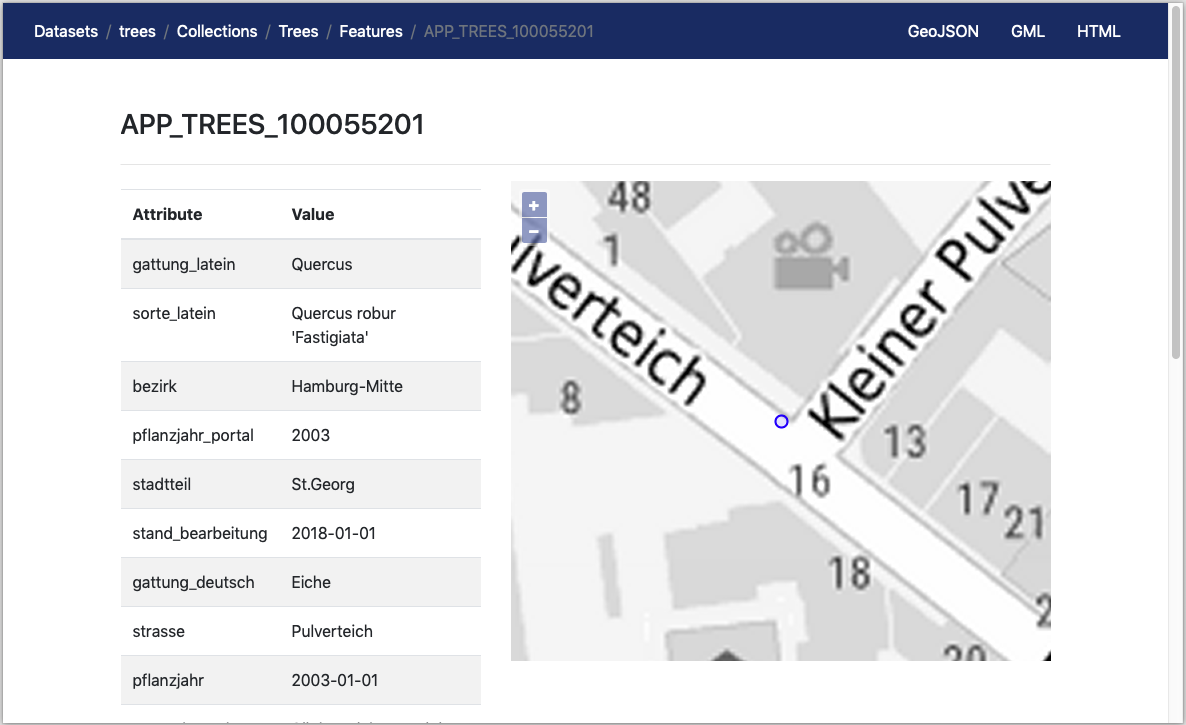
6.9. Using query parameters
The following query parameters are supported when using HTTP GET:
| Query parameter name | Value type | Example value | Description |
|---|---|---|---|
|
String |
EPSG:4326 |
EPSG code defines the CRS of the returned data |
|
Comma separated floating point values |
567190,5934330, 567200,5934360 |
List of comma separated floating point values defining a bounding box |
|
String |
EPSG:4326 |
EPSG code defines the CRS of the coordinates of the |
|
String |
json |
Requested encoding of a given resource, can be |
|
integer |
10 |
Limit the numbers of items per page |
|
integer |
0 |
Start index of items |
|
boolean |
true |
Applicable for features resource only, can be combined with parameter |
|
Note
|
Check the OpenAPI document on which resources the listed query parameters are supported. Additional query parameters may be available depending on the resource. |
7. Help
This section show how to get help in case of problems.
7.1. Known Issues
-
Mixing legacy service configuration with OGC API configuration is currently not supported by deegree OAF webapp. See the FAQ how to serve your data with deegree webservices and deegree OAF from the same workspace configuration.
-
Startup time of deegree OAF webapp may increase noticeably when the deegree workspace contains many resources (e.g. more than 100 files).
-
Using the browser’s navigation buttons when using the HTML view may result in empty pages or the switch to JSON encoding. Affected browsers: Google Chrome, Chromium. You can avoid this by enabling the Vary HTTP response header in your HTTP server configuration. Check the HTTP server documentation how to configure this.
7.2. Support
Use the deegree support options (mailing lists, commercial support) to get help.
7.3. FAQ
-
How to update the bbox_cache.properties?
Use REST-API operation
/config/update/bboxcacheto recalculate the bounding boxes of the feature stores. See section deegree config REST-API for more information how to use the REST-API. -
How to migrate an existing deegree workspace?
Given that an existing deegree workspace contains at least one feature store the following steps need to be done to provide the data via deegree OAF webapp:
-
Add a dataset configuration file in subdirectory ogcapi/, e.g. streets.xml as described in the example workspace in chapter Dataset configuration.
-
Configure the HTML encoding by adding a file in subdirectory html/ (optional), e.g. streetsview.xml as described in the example workspace in chapter HTML encoding configuration.
-
Deploy the deegree OAF webapp as described in chapter Deploy the webapp.
-
Add mapping entry to webapps.properties file to select the deegree OAF workspace for the deegree OAF webapp.
-
-
How to use the same workspace with deegree OAF and deegree webservices?
Deploy both webapps for deegree OAF and deegree webservices configured to use the same workspace called ogcapi-workspace. Use the file webapps.properties to configure this. Keep in mind that deegree OAF will provide the OGC API - Features and deegree webservices will provide only the legacy service implementations. You may see warnings in the logging messages for both instances that configuration files have been ignored.
-
How to deploy multiple instances of deegree OAF webapp?
Multiple deployments of the webapp are possible. Since each instance of the runtime environment can host one or more webapp. For every deployed webapp there must be a deegree workspace available with the name ogcapi-workspace. It is possible that multiple instances of the webapp can share one single instance of a deegree workspace, for example a setup serving the same data by multiple instances in a load-balancing scenario. To serve different data configured in different deegree workspace’s you need to run multiple instances of the runtime environment. Use the environment variable
DEEGREE_WORKSPACE_ROOTto set the path to the deegree workspace directory. Read further in section Configuration about the deegree workspace and configuration files.